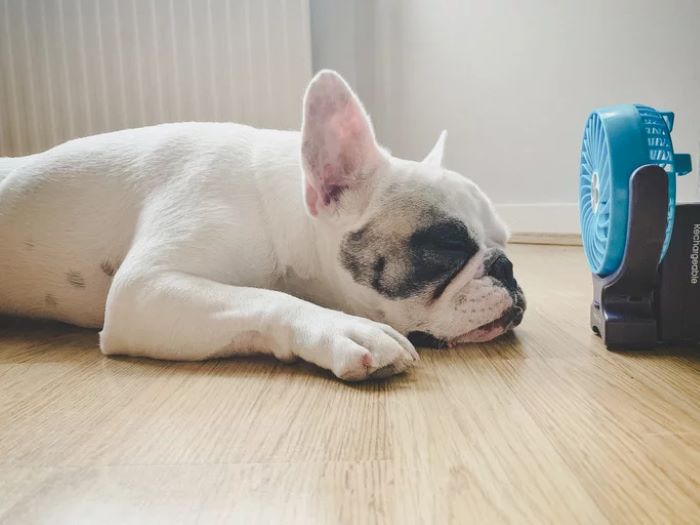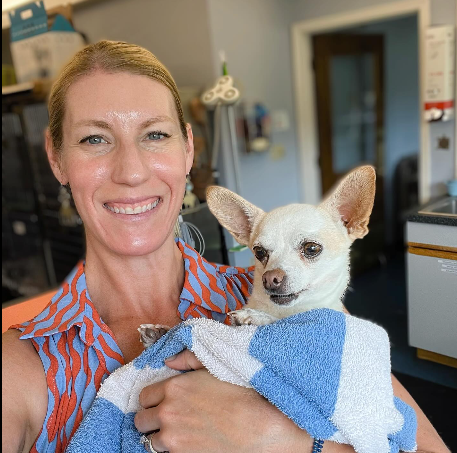Like people, dogs might occasionally crave solitude for a variety of reasons, so a dog sitting by itself in a different room could be a sign of several different issues. It can just come down to personal preference or level of comfort. Depending on where they feel most comfortable, dogs may go to the colder or warmer parts of the house. It may also indicate a need for relaxation or personal space. Like people, dogs may crave isolation or alone time when they’re feeling overburdened, tense, or exhausted. It might also be the result of a habit or behavior they’ve picked up. Some dogs may want to sit by themselves in a different room because they are naturally drawn to calmer environments or places where they feel safe. Moreover, a dog may want seclusion due to discomfort or health concerns. They may look for a peaceful area to rest or recuperate if they are experiencing pain, illness, or discomfort. It is best to keep a close eye on their behavior and see a veterinarian to rule out any underlying health issues if their behavior is odd or there are worries about their wellbeing..
Table of Contents
Dogs Follow The Temperature

Dogs are sensitive to temperature changes and frequently look for cozy places to be. The changes in temperature may cause them to behave differently. Dogs may seek out cooler locations in warmer weather, such as well-ventilated or shady settings, to prevent overheating. In contrast, in order to stay warm and preserve body heat in colder weather, individuals could look for comforting spaces, warmer places, or heated regions. Dogs are naturally inclined to seek out situations that best suit their comfort levels, and they frequently exhibit a preference for areas that meet their temperature requirements. It might be beneficial to their general comfort and well-being to recognize and respect their preferred temperature, enabling them to unwind and flourish in their surroundings.
Providing Comfortable Resting Areas
Providing your dog with cozy places to sleep is essential to understanding why they prefer to sit by themselves in a different room. Dogs frequently look for pleasant places to rest and relax, such soft blankets or nice beds. Having these spaces set apart for them satisfies their innate need for a cozy, secure environment, which influences where they choose to relax or take a break. Your dog can unwind and rejuvenate in comfortable resting areas that offer them a sense of security in addition to physical comfort. These cozy areas are even more important for elderly or sick dogs since they relieve joint discomfort and promote general comfort. Recognizing and honoring your dog’s desire for these places contributes to the creation of a safe and soothing atmosphere, encouraging them to withdraw there in times of need for peace and quiet. If your dog routinely selects certain cozy spots to rest in another room, it may indicate that they prefer a calm and serene place to relax or feel safe, which is good for their general wellbeing and satisfaction.
Disturbance from Other Animals
One reason a dog could seek solace in a different room could be noise from other animals. Like people, dogs have particular preferences for their own spaces and quiet times. It can occasionally be upsetting for a dog to be among other animals, whether they are pets or even wild creatures. They may decide to move to a more private or quieter area of the house in response to this disturbance. Dogs may become uncomfortable or stressed out by the sounds, movements, or simple presence of other animals, which may cause them to look for a more peaceful and unobtrusive area. This can also be a result of their innate tendencies., where dogs might look for seclusion or a place distant from possible rivals or causes of strife. You can determine whether your dog’s demand for seclusion in another room is being influenced by the presence or actions of other animals by keeping an eye on when and how your dog seeks out isolation. Changing the surroundings or giving your dog access to a calm, secure area could lessen this disruption and provide them with the comfort they need.
Escape From The Human Family
Despite being gregarious animals by nature, dogs may occasionally seek out isolation from their human family for a variety of reasons. This may be an attempt to avoid being with people all the time, particularly when there’s a lot going on in the home, or when there’s too much attention or noise. Like people, dogs sometimes long for quiet times, withdrawing to more peaceful areas to relax or just take in the silence. Additionally, it could be a coping strategy for them to control stress or overstimulation, giving them time to unwind and find their own peace. Some dogs may seek comfort in another room if they feel overwhelmed in very dynamic householdsFurthermore, this tendency can be an innate desire for occasional privacy or a regular choice. It is critical to a dog’s wellbeing to acknowledge and honor their need for privacy. Allotting specific spaces for them to be quiet or making sure they have some peace during family events can provide them the space they need without compromising their integration into the home. Comprehending the necessity of these intervals might greatly enhance their psychological and affective equilibrium.
Relaxation Time
Making your dog’s environment calm and comfortable is crucial to their overall wellbeing. Like people, dogs too benefit from occasional periods of peace and quiet. It’s critical to provide your dog a peaceful area to relax and decompress. This could be a quiet room in your house or even a quaint spot with a comfy bed that is away from busy streets.
They can relax more easily if they set aside specific times for it, especially after active or playtime. Reduced noise levels, a calm atmosphere, and soft, supportive bedding can all help them unwind. Moreover, supplying them with a secure and cozy space to feel safe and comfortable adds to their general relaxation.
It’s also possible to read your dog’s body language and behavior to determine when they need downtime. Indications of wanting to unwind could include reclining down, stretching, or letting out long, heavy breaths. You’re promoting your furry friend’s mental and emotional health by creating a calm environment and acknowledging their need for rest. This will make your pet happier and more at ease.
Sometime Sick Dogs Like To Be Alone
Sometimes sick pets would rather be left alone. In times of illness or discomfort, dogs may want to isolate themselves. They typically withdraw to a quiet area to relax and recuperate, thus this behavior is frequently a natural reaction to feeling ill. Like people, dogs can show symptoms of disease or discomfort, which makes them seek out a private place apart from family activities. They may also be able to preserve energy and concentrate on healing through this seclusion. If your dog is sick and sitting by themselves in a different room, it may be a sign that they are unusually tired, uncomfortable, or even in painYou can identify the underlying problem and make sure they receive the required care and attention by keeping an eye on their behavior and consulting a veterinarian. A sick dog needs a quiet, cozy space to recuperate from their illness, giving them the rest and quiet they need at this time.
Dogs Sit Along For All Sorts Of Reasons
For a variety of reasons, dogs sit by themselves. This is a behavior that may be the result of their unique needs, emotional states, or preferences. While some dogs are inherently drawn to peaceful areas for rest or relaxation, others may choose seclusion as a result of stress, worry, or illness. Additionally, a dog may sit by itself in search of interaction or activity if it is bored or receives little mental or physical stimulation.
Their aging may also affect their behavior, making them favor calmer environments or places where they feel more comfortable. Dogs may choose to be by themselves to avoid distractions or overindulgent attention, or they may just want to spend some quiet time by themselves. Determining the reason for a dog’s decision to sit alone requires an understanding of the situation and careful observation of their behavior patterns. Their specific needs for isolation can be met by attending to them, creating a cozy and secure atmosphere, and giving appropriate mental and physical stimulation.
A Dog’s Signs of Fear or Anxiety When It Sits Alone
Dogs that desire isolation may exhibit obvious symptoms of fear or distress. Even though every dog is different, restlessness, excessive panting, pacing, or whining are typical indicators of worry or distress when a dog is sitting by themselves in a different room. A stiff torso, lowered ears, or a tucked tail may be signs of pain. Their body language can also provide information. Anxiety may also be indicated by excessive grooming or even destructive activity, such as biting on things or scratching at doors. Certain dogs may behave in an avoidant manner, making no eye contact or adopting a submissive stance. Some may look for places to hide or make an attempt to flee, which is a sign of extreme stress.
But it’s important to take into account other elements and their general behavior. Sometimes a dog’s need for solitude or rest is expressed when it sits by itself; it’s not necessarily a sign of fear or worry. It is possible to determine whether fear or anxiety are the underlying reasons of this behavior by paying attention to the context, frequency, and other cues associated with it. Ensuring their emotional well-being can be achieved by creating a peaceful environment, offering support and reassurance, and obtaining professional counsel to help ease their distress.
Symptoms That Your Dog Is Sitting Alone Because of Pain or Illness
There are a number of signs that your dog is sitting by himself because he is in discomfort or unwell. A decline in activity levels, a reluctance to participate in activities they often like, or a noticeable fall in appetite are examples of behavioral changes that might be observed. A dog that is hurting or sick may show symptoms of discomfort, like limping, showing preference for particular body parts, or refusing to be touched in particular places. They may also exhibit peculiar vocalizations, such as whimpers or whining. Any alterations to their typical sleeping habits, such as trouble falling asleep, agitation, or frequent moving, may also indicate discomfort..
Changes in their body language or posture, such as tense muscles or a hunched back, could be signs of discomfort or pain. Increased licking or grooming in a specific location may potentially indicate an injury or source of discomfort. Additionally, any changes in their bathroom habits, including having accidents indoors or having difficulty going to the bathroom, could indicate a medical condition.
Symptoms of Your Dog’s Boredom or Lack of Stimulation When Sits Alone
When your dog is left alone, boredom or a lack of stimulation may show up as a variety of behaviors and indications. A bored dog may pace, show signs of restlessness, or let out long, loud sighs. They might exhibit habitual actions such as excessive chewing, licking, or scratching, especially if it is aimed at them or other items in the vicinity. Digging or chewing on furniture are examples of destructive activity that may also be a sign of low mental or physical stimulation.
Furthermore, a dog that is not mentally engaged may appear bored or unresponsive to routine tasks or directions. They may playfully prod or prod at family members or engage in other attention-seeking activities in an attempt to get attention. Their need for stimulation may be indicated by a greater need for engagement or more frequent vocalizations. In an effort to pass the time or attract attention, some dogs may even take to wailing or barking.
Signs of Your Dog Sitting Alone Due to Aging
Aging-related changes in your dog’s mobility or movement may be indicators that he sits alone. Elderly dogs may exhibit symptoms of stiffness or gait problems, particularly following extended periods of inactivity. They may show signs of decreased energy or a reluctance to partake in activities they used to like. They may also be less willing to engage in physical activities. Older dogs may also take longer to settle or wake up and may spend more time in peaceful, isolated places in search of comfort and calm..
Their sleep habits may also change as a result of the behavioral changes, with more frequent daytime naps or sleeps. Certain elderly dogs may vocalize more than others, perhaps as a result of bewilderment or discomfort brought on by age. They may also exhibit cognitive abnormalities, such as confusion or forgetfulness, which could explain why they seek for familiarity or seclusion in more sedate environments.
It’s crucial to provide a cozy and accessible space for an elderly dog, with soft and supportive bedding and as little steps or excessive movement as possible. To ensure their comfort and well-being in their senior years, routine veterinary check-ups can assist monitor their health and manage any unique needs or issues connected to aging.
How to Help Your Dog if They Sit Alone in Another Room
Understanding your dog’s behavior and meeting their requirements in accordance with it is necessary to assist them when they seek solace in another room. Creating a cozy and secure atmosphere is essential. Make sure they have access to nice beds or blankets or other comfortable resting places so they can unwind and feel safe. When they need time to themselves, they can retire to a peaceful, unoccupied area of the house.
It’s crucial to regularly partake in interesting activities to fight boredom. Boredom can be reduced and both mental and physical exercise can be obtained by daily walks, interactive play, and mentally stimulating items. It’s also crucial to offer comfort and social connection. To help your dog feel safe and loved, spend quality time with them by showing them affection, care, and company.
Conclusion
Understanding the reasons behind a dog choosing to sit alone in another room is an integral aspect of responsible pet ownership. Dogs, like humans, have their own set of emotions and behaviors, and their desire for solitude may stem from various factors. Whether seeking a quiet moment, feeling unwell, or simply needing a break, it’s crucial for pet owners to respect their furry companion’s autonomy.
In concluding this exploration into the reasons why a dog may choose solitude, fostering open communication, observing behavioral cues, and providing a safe, comfortable environment are essential. By maintaining a keen awareness of our canine friends’ needs and preferences, we can strengthen the bond between humans and their loyal companions, ensuring a harmonious and understanding relationship. Remember, each dog is unique, and the key lies in acknowledging and embracing the individuality of our beloved pets.

Dr. Allison Kramer is a seasoned veterinarian with a Master’s degree in Animal Behavior and over 10 years of experience specializing in canine health and behavior. Her expertise in positive reinforcement training and holistic care enhances the well-being of dogs and fosters strong pet-owner relationships. For expert advice and valuable insights, follow Dr. Kramer on Instagram @dr.allisonkramer.





